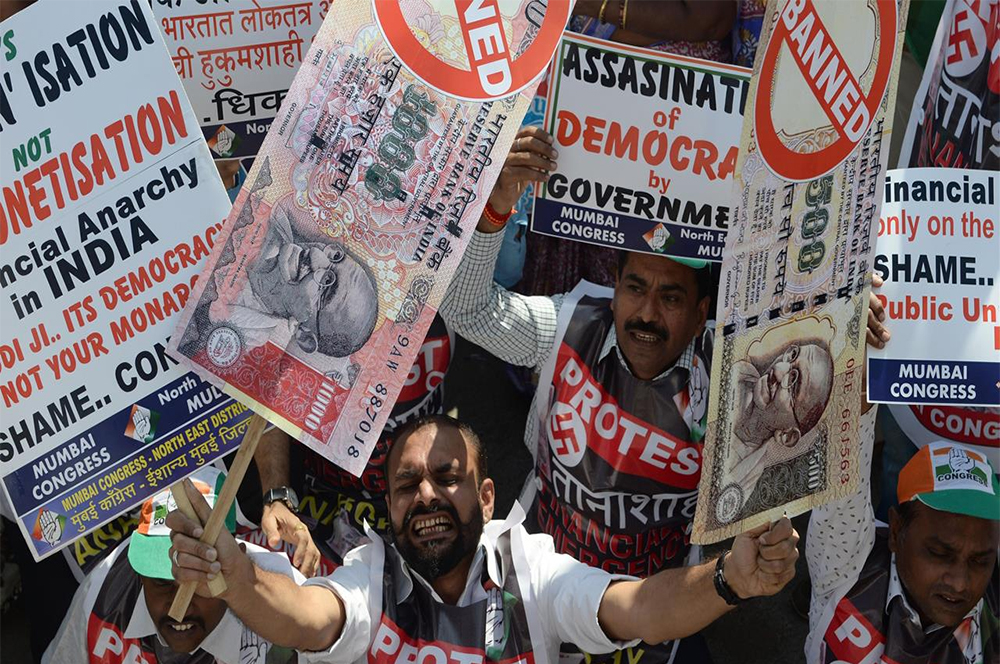Over three decades, Sri Lankan Tamil businessman Sundar Thangarajan built a stash of Indian bank notes totaling the equivalent of $2,000 as insurance if he had to move to India from the island where the ethnic minority has often felt under siege. But on a visit to the southern Indian city of Chennai this April, Thangarajan decided he would no longer save Indian notes, and instead bought gold bars. His insecurities in Sri Lanka haven’t disappeared. But his faith in Indian currency has vanished now that his savings have turned to scrap.
Thangarajan is among millions across South Asia hurting from India’s decision last November to ban — overnight, with no advance notice — currency notes of 500 and 1,000 rupees (about $8 and $16) that comprised 85 percent of all available Indian cash at the time. The note ban, India argued, was aimed at uncovering undisclosed wealth and tackling fake currency within its borders. But for decades, these notes have been the savings Nepalese workers in India sent home, a source of security to war-ravaged Afghans and Sri Lankan Tamils, and a route to health, education and prosperity for patients, students and traders from Bangladesh, Bhutan and Myanmar.
"PEOPLE ACROSS SOUTH ASIA WILL ASK, ‘WHAT WILL INDIA DO NEXT?’"
Now, saddled with wads of unusable notes, many of them are weaning themselves off the “regional dollar,” as some refer to the Indian rupee, which is the largest and most stable currency in the neighborhood. Some, like Thangarajan, are buying gold as security; others, American dollars. Still others are discovering merits in their national currencies. The glint of the Indian rupee has dimmed for them. “This is natural,” says Vivian Dzokoto, an associate professor at Virginia Commonwealth University, who has researched past demonetization exercises internationally and their social impact. “People across South Asia will ask, ‘What will India do next?’ ”
Pakistan, Myanmar, Zimbabwe, Nigeria, Ghana and North Korea have all tried demonetization. But none of them had economies the size of India’s, and the impact of the moves on neighbors was negligible, say experts. Unlike the gradual shift proposed by advocates of less cash like Harvard University’s Kenneth Rogoff, India’s initiative also was sudden.
To be sure, broader economic shifts in major economies have hit smaller neighbors in other cases. The 2014 ruble crash following Western sanctions against Moscow and a slump in global oil prices also pulled down Russia’s neighboring economies that relied on the currency for trade and remittances. China’s recent slowdown has hurt neighbors dependent on trade with Beijing. And when the U.S. stumbles, as it did during the Great Recession, the world’s economy suffers.
But unlike those cases, India itself planned the November decision. Yet Nepal and Bhutan, the two other countries that legally allow the use of the Indian rupee, weren’t warned. That’s a good way to upset the neighbors. The worst hit was Nepal. “India should have ideally discussed its plans with us earlier,” says Deep Upadhyay, Nepal’s ambassador to New Delhi.
India, overwhelmed by the initiative’s domestic fallout — a severe cash crunch meant empty ATMs, long queues and a dip in economic activity — insists it remains “hopeful” of “a solution” with neighbors, says diplomat Sudhakar Dalela, who is in charge of ties with Nepal and Bhutan at India’s foreign office.
But India’s neighbors are suspicious.
Nepalese citizens hold an estimated $500 million in the banned notes, most of them sent back as savings by the more than one million Nepalese nationals working in India, says Chiranjibi Nepal, governor of the country’s central bank, the Nepal Rashtra Bank. Yet seven months after the ban, India has yet to exchange those notes with valid ones. Talks are on with India’s central bank, he says. As for Bhutan, its nationals hold $16 million in defunct Indian notes, says Dasho Penjore, governor of the country’s central bank, the Royal Monetary Authority.
For the moment, Nepal and Bhutan are not decoupling their deeply dependent economies from India’s. But many individuals with ties to the rupee are now showing no compunction in jettisoning the currency.
On a sweaty morning in April, Afghan carpet seller Amir Shah stood with four compatriots before the gates of India’s central bank in New Delhi, pleading with security guards to let him exchange banned notes. He was denied: Only Indians who were abroad in November can exchange notes until June. “Never again,” Shah declares now. “From now on, I’m going to convert rupees I earn into U.S. dollars.”
Dhaka-based Ashraf Sheikh had brought his mother to Bangalore for a cardiac bypass surgery — more than 50,000 medical patients from Bangladesh visit India each year for treatment — when the note ban was announced. Instead of attending to his mother, he says, he had to hustle to exchange the 25,000 rupees ($400) he had brought for hospital expenses. He too decided then never to save the currency again.
Sri Lankan travelers to India also lost their savings. Currency changers in the capital city of Colombo stopped accepting banned Indian notes immediately after the November announcement, says David Benedict, director of the Sri Lanka Money Brokers Association. Students from Myanmar in India were affected too. Zaw Min, a student of political science, lost 25,000 rupees ($400) because he was home on vacation in November.
The macroeconomic effects of the note ban on South Asian economies are likely temporary, experts concur. And the move may help the Indian economy in the long run, says Shrinivas Patil, an economist based near Bangalore who researches the rupee’s international reach.
Restoring the trust millions across South Asia had in the Indian currency may prove tougher, though. “When faith in a currency drops,” Dzokoto says, “that is difficult to build back.”

